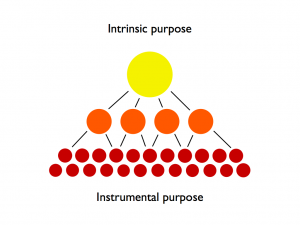The evolutionary pattern of wholes, or holons, is helpful to understand purpose at scale. To explore this, I draw on the work Arthur Koestler, Ken Wilber and Steve McIntosh, who articulate the sequence of evolutionary emergence where each evolutionary entity, or level, is a whole and a part. Each whole is also a part of larger wholes. Marilyn Hamilton’s nested holarchy of city systems (Figure A) is an example.
Holons, which are each whole, are nested as parts of other holons/wholes. The smaller wholes are more numerous. Imagine the cells that make up your body; they are far more numerous than the one whole body that is you. Likewise, you are one whole, along with many others, that make up the whole family to which you belong, or the organization where you work, or your neighbourhood or city, nation or species.
In looking at the scale of wholes, that are both parts and wholes themselves, the smaller entities are ‘fundamental’ and ‘instrumental’. Without these smaller wholes to form part of the larger whole, the larger whole does not exist. The smaller the holon, the more fundamental; the more larger holons emerge, the more fundamental the smaller ones become.
Larger holons emerge as entities that transcend and include the smaller holons in new combinations. The larger holons are not fundamental, but rather ‘significant’. McIntosh on Wilber:
…as evolution produces larger and larger encompassing holonic levels, each new level contains more and more parts and thus more and more whole entities. And as holons come to embrace more whole/parts within themselves, this increases their intrinsic value, or what he calls their ‘evolutionary significance (McIntosh, p. 124-125).’From an evolutionary perspective, larger holons are more significant than their smaller counterparts, while the small holons remain, and become, more fundamental.
There are two value pulls here: one toward the smaller, fundamental value of encompassed parts, and a second toward the increasing significant value of emergent wholes. While these ‘pulls’ are in opposite directions, they are complementary; they co-exist in relationship with each other. As wholes become larger and more significant, the component wholes that are part of that whole become more fundamental. For McIntosh, this is the nature of evolutionary progress as described by Wilber.
As for evolutionary purpose, McIntosh sees the same complementary relationship between holons with new language: the encompassed parts are of instrumental value, and the emergent wholes are of increasing intrinsic value. Smaller holons serve instrumental purposes and larger holons serve intrinsic purposes.
From an evolutionary perspective, at a macro scale, what happens to purpose at different scales?
For McIntosh, the intrinsic purpose, or value, of evolution itself is not static: “its value is ‘alive, free, thrilling, and always moving (McIntosh, p. 160).'” Yet is also moving in a direction, toward goodness, beauty and truth. Intrinsic purpose is grand and shifty.
The process of growth, however, also involves parts that are no longer growing or emerging, yet they “nevertheless [contribute] to the growth of the emergent levels which encompass those parts as a foundation for further growth (McIntosh, p. 160).” The holons that are encompassed as parts of larger wholes are of instrumental value to the more complex system of which it is a part. Small holons are in service to larger, more significant holons. They are of instrumental purpose.
Recognizing that larger holons are more significant than smaller holons does not negate the value of smaller holons, for they are fundamental. McIntosh puts it bluntly: ” instrumental value is the complementary equal of intrinsic value (McIntosh, p. 156).”
This exploration is a reminder that small entities are building blocks, and their health and well-being have instrumental purpose and value to the entities in which they are part. It is a legitimate, and not lesser, role to play in evolutionary progress. For McIntosh, this “two-fold purpose that orients our personal development is grounded in evolution’s essential organizing structure of wholes and parts, wherein every whole is also a part and vice a versa. Every evolutionary entity thus partakes of both kinds of purpose (McIntosh, p. 155).”
Every entity is a whole and a part. Every entity has instrumental and intrinsic purpose.
What is your intrinsic purpose?
In what are you of instrumental value?
_____ _____ _____
This post forms part of Chapter 5 – Destination Alive or Adrift, of Nest City: The Human Drive to Thrive in Cities. Click here for an overview of Chapters 4-7 (Part 2 – Organizing for Emergence). Click here for an overview of the three parts of Nest City.
_____ _____ _____
Further reading…
Koestler, Arthur. A Brief History of Holons, by Mark Edwards
McIntosh, Steve. Evolution’s Purpose: An Integral Interpretation of the Scientific Story of Our Origins
Wilber, Ken. Integral Psychology: Consciousness, Spirit, Psychology, Therapy
